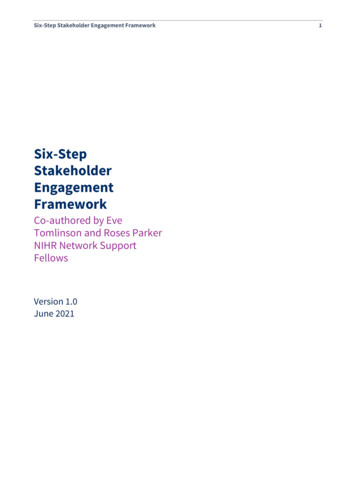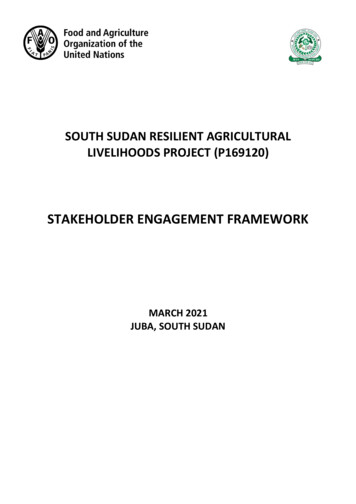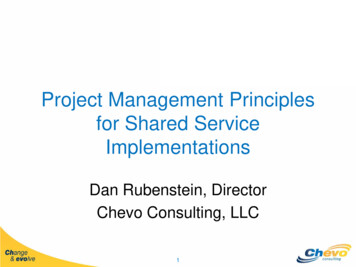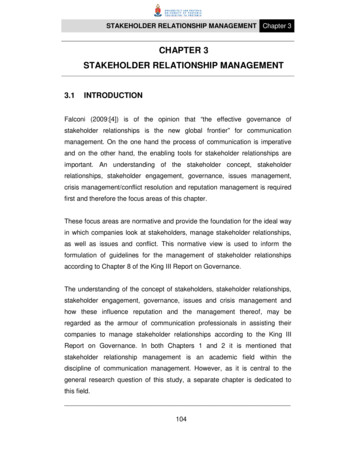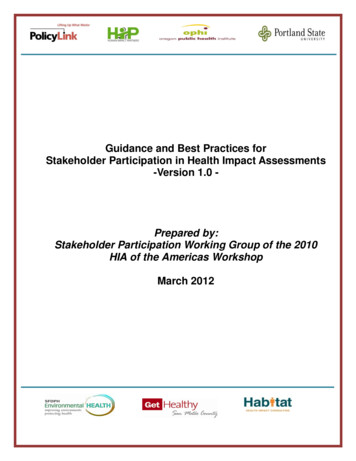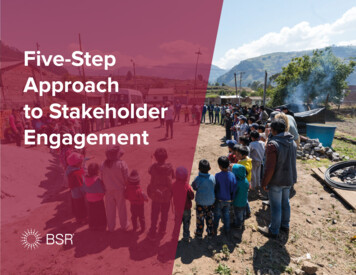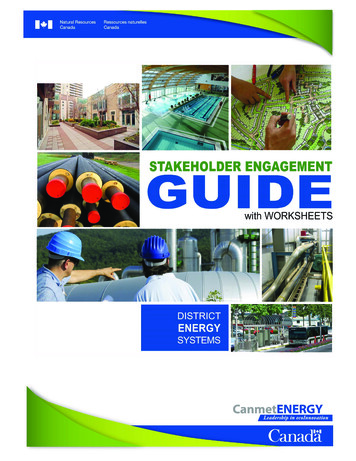
Transcription
Stakeholder Engagement Guide with Worksheets
Acknowledgement:This Engagement Guide was extracted from the report, Stakeholder Communications and Engagement Guidefor District Energy Systems, developed by Sustainable Cities International for Natural Resources Canada’sCanmetENERGY Communities group, 2014.Neither Natural Resources Canada nor any of its employees makes any warranty, express or implied, or assumes any legal liability orresponsibility for the accuracy, completeness or usefulness of its contents. Reference in the report to any specific commercial product,process, service or organization does not necessarily constitute or imply endorsement, recommendation or favouring by NaturalResources Canada. The views and opinions of authors expressed in this report do not necessarily state or reflect those of NaturalResources Canada.Funding for this work was provided by Natural Resources Canada through the Program of Energy Research and Development.Ressources naturelles Canada et aucun de ses employés ne font aucune garantie, formelle ou tacite, et n’assument aucuneresponsabilité légale ou autre à l’égard de l’exactitude, de l’exhaustivité ou de l’utilité du contenu du rapport. Toute référence dans lerapport à quelque produit, processus, service ou organisation que ce soit ne constitue pas nécessairement une approbation, unerecommandation ou une préférence de la part de Ressources naturelles Canada. Les points de vue et les opinions exprimés par lesauteurs dans ce rapport ne sont pas et ne reflètent pas nécessairement ceux de Ressources naturelles Canada.Ces travaux ont été réalisés grâce au financement fourni par Ressources naturelles Canada dans le cadre du Programme de recherche etde développement énergétiques.Cat. No. M154-80/2014E-PDFISBN or ISSN 978-1-100-24705-2 Her Majesty the Queen in Right of Canada, as represented by the Minister of NaturalResources, 2014
TABLE OF CONTENTSINTRODUCTION . 5A: RATIONALE FOR CREATING AN EXTERNAL PUBLIC ENGAGEMENT STRATEGY . 5B: STEPS IN PLANNING AN EXTERNAL ENGAGEMENT STRATEGY . 6STEP 1: Understand the Local Context . 7STEP 2: Identify Stakeholders and Conduct Stakeholder Analysis. 82a) Stakeholder Identification. 82b) Stakeholder Analysis . 10Guiding Questions for Stakeholder Identification & Analysis: . 12Example: Stakeholder identification and consultation for neighbourhood energy utility in Vancouver . 13STEP 3: Determine Key Messages . 143.1) Use Mental Models and Framing to Enhance Message Delivery .143.2) Create Messages to Address Specific Needs and Concerns .16STEP 4: Select Appropriate Public and Stakeholder Engagement Channels . 18Developers . 19Mass versus targeted communication: .20Mass Communication/Engagement Approaches: .20Targeted Communication/Engagement Approaches: .23Example: The Value of Using Multiple Engagement Tools .26STEP 5: Create an Integrated Implementation Plan . 27C: POTENTIAL FUTURE ACTIONS – DESIGN A MUNICIPAL ENGAGEMENT STRATEGY. 28Phase 1: .28Phase 2: .28D: APPENDIX & WORKSHEETS . 29WORKSHEET 1: THE PROJECT SCOPE AND CONTEXT .30WORKSHEET 2: STAKEHOLDER IDENTIFICATION AND ANALYSIS - LISTING.31WORKSHEET 3: STAKEHOLDER IDENTIFICATION AND ANALYSIS - CLASSIFICATION .32WORKSHEET 4: STAKEHOLDER IDENTIFICATION AND ANALYSIS - PRIORITIZATION .33WORKSHEET 5: STAKEHOLDER IDENTIFICATION AND ANALYSIS - STRATEGIZING .34WORKSHEET 6: COMMUNICATION MESSAGES AND PLATFORMS .35WORKSHEET 7: IMPLEMENTATION PLAN .36Examples: District Energy communication developed by Municipalities . 37BONNYBROOK CENTER: OPEN HOUSE POSTER BOARDS.37WHITEHORSE: DISTRICT ENERGY SYSTEMS POSTERS .38WHITEHORSE: DISTRICT ENERGY SYSTEMS POSTCARDS .38E: REFERENCES . 39
DISTRICT ENERGY STAKEHOLDER ENGAGEMENT GUIDEINTRODUCTIONThis guide is intended to assist Municipalities in developing their local StakeholderEngagement strategies when considering District Energy. A District Energy System (DES) mayalso be referred to as a Thermal Grid (providing either heating and/ or cooling), and may alsobe a provider of locally generated electricity supplies (called co-generation), use localsources of renewable fuels to power the system, and have local renewable energy storagecapacity. A District Energy System is an incremental step towards a long term goal and assuch the engagement strategy should be considered not as a single event but rather as anongoing activity.There are many examples of local district energy solutions, nationally and internationally,some of which can be found in the resources section of this Guide. However, the focus ofthis guide is not on the technical aspects of District Energy development. Rather, it is a toolto help steer the Engagement process between a municipality and their local externalstakeholders. For more information on District Energy technical issues and resourcesfor Municipalities, such as the DE Learning Module for Municipal Planners, contactde@nrcan-rncan.gc.ca.This Guide, with Worksheets and samples of some existing stakeholder communicationproducts from municipalities, is based on the fundamental principles for communityengagement, and has been developed as a starting point for Municipalities to utilize, oradapt, when they decide to proceed with development of a District Energy strategy.A: RATIONALE FOR CREATING AN EXTERNALPUBLIC ENGAGEMENT STRATEGYMisconceptions exist around district energy systems. Potential end users,stakeholders, and municipal staff and elected officials may not be fully aware of howdistrict energy systems work, their benefits, and contribution to enhancing thesustainability of communities (Canadian Urban Institute, CUI, 2011).This lack of awareness and misunderstanding is a barrier to district energy growth. Itdiminishes political leadership and the development of effective policies or incentivesto foster greater deployment. In turn, economic challenges prevail. The failure of theindustry to deliver a persuasive and well-defined message about district energy oftenlessens the interest in tackling the knowledge challenge (CUI, 2011).For more information, contact CanmetENERGY: de@nrcan-rncan.gc.ca5
DISTRICT ENERGY STAKEHOLDER ENGAGEMENT GUIDEGreater and effective communication, successful stakeholder engagement and strongbrand positioning are thus vital in addressing misconceptions, growing knowledgearound this technology, and leveraging its integration into energy planning incommunities.Besides tackling the preceding challenges, effective public and stakeholderengagement offers a number of broader benefits (Vanderheiden, 2008; Gonzalez &Tyler, 2007; Scholsberg, 1999 in Paavola, 2008; Thibault & Walker, 1975 in Lind &Tyler, 1988; Few et al., 2006 in Bjornberg & Hansson, 2011). It allows people to present their views and have some control over policiesthat affect them.It enables governments to learn valuable information from local knowledge inorder to make more informed and sustainable decisions.It helps to increase the legitimacy of policies.It makes initiatives easier to implement and more readily accepted.It enhances trust between stakeholders and government.If a just and inclusive process is used, there is a greater chance of achievingdesirable and fair outcomes.Due to the complexity of district energy systems and the diversity of the stakeholders,it is important for an engagement strategy to follow a structured and informedprocess. This process is discussed in the remainder of this guide.B: STEPS IN PLANNING AN EXTERNAL ENGAGEMENT STRATEGYFive major steps are recommended when developing an engagement strategy for districtenergy. The next few sections outline each one in further detail.For more information, contact CanmetENERGY: de@nrcan-rncan.gc.ca6
DISTRICT ENERGY STAKEHOLDER ENGAGEMENT GUIDESTEP 1: Understand the Local ContextPublic and stakeholder engagement is not a one size fits all exercise. It isfundamental to analyze the context in which engagement is beingundertaken. This will enable municipalities to understand the complexityof district energy; the human resources needed; how it fits into overall municipalplanning, policy-making, including capitalizing on other related planning opportunities;and the influence of the local political philosophy on district energy. As such, five keyfactors need to be considered.1. Leadership: A community champion is vital in driving district energy forward. Thiscould be a senior municipal staff member or politician or someone else in thecommunity (e.g. representative from industry or non-governmental organization).2. Capacity Building: Municipal councillors and staff that could oversee energy planningand specific projects should understand how district energy systems work, theirbenefits, whether it is feasible to institute them in their community, and how toimplement them from an operational and community engagement perspective. Thismay require building awareness of district energy through workshops or othercapacity building methods to achieve strong internal support for sustainable energysystems. This particular guide focuses on external stakeholders rather than internalones but a communication and engagement strategy needs to be developedseparately for the latter target audience as well.3. Integration: It is important to understand how district energy may be integrated intooverall city planning, complement long-term municipal objectives and piggyback onother similar activities. For instance, it can be embedded in high level municipalplans such as an Official Community Plan or Integrated Community SustainabilityPlan, or in specific plans like a Community Energy and Emissions Plan or ClimateChange Action Plan. Furthermore, district energy can be incorporated with otherspecific sustainability or climate change initiatives. Considering district energy withinthe broader picture of municipal planning is wise since energy planning isinterrelated with land use, transportation, and sustainability planning, especiallywhen aiming to increase urban densification. When integrating district energy intolong range planning, local governments still need to present convincing reasons forbeing involved in community energy planning and considering district energy, asenergy provision is not traditionally a key responsibility of municipalities. Usually, thisis handled by provincial and federal governments.For more information, contact CanmetENERGY: de@nrcan-rncan.gc.ca7
DISTRICT ENERGY STAKEHOLDER ENGAGEMENT GUIDE4. Policies and Regulations: A much debated topic is whether to create by-laws that requiremandatory connection to district energy systems, allow optional connection to thesesystems, or stipulate new buildings to be district energy ready. There are pros and conswith each approach. If potential customers are forced to join a district energy system,municipal government may face more opposition from clients even though greater use ofthe system will be achieved. On the other hand, selling new clients on district energy toencourage use will eventually create greater support but it will take longer to foster morewidespread deployment. The third option - requiring new buildings to be district energyready – provides a middle of the road solution. People may be more accepting of itbecause it does not require immediate action. However, it does delay connections to afuture date.5. Political Environment: The final point to consider is the political orientation or philosophyof city councillors and the mayor. This may affect the direction taken in energy planningas well as the type of communication messages delivered to different audiences.Once the local context is fully understood, municipalities should then identify the key goalsand objectives of their engagement strategy before proceeding through the next four steps.STEP 2: Identify Stakeholders and Conduct StakeholderAnalysis2a) Stakeholder IdentificationBefore determining appropriate engagement methods and developing communicationmessages, it is important to first identify key stakeholders. Stakeholders are internal andexternal organizations and individuals that have a vested interest in or are directly orindirectly impacted (International Finance Corporation, IFC, 2007). As previously indicated,the engagement and buy in of internal stakeholders (municipal staff) is essential but not thefocus of this document.In order to determine stakeholders, a number of tools may be utilized, includingbrainstorming, mind mapping, generic stakeholder lists, and reviewing previous similarprojects with stakeholder identification and consultation (Morphy, 2013b). By reviewing priorprojects, one can learn about possible risks and unresolved concerns as well as reduce thetime needed to identify stakeholders. Potential sources of information may include impactassessments, consultation and grievance logs, project stakeholder lists and reports (IFC,2007).For more information, contact CanmetENERGY: de@nrcan-rncan.gc.ca8
DISTRICT ENERGY STAKEHOLDER ENGAGEMENT GUIDEIn the context of district energy, the following seven main external stakeholders have beenidentified:1. Developers: This category encompasses all professionals involved in designing andconstructing new buildings. Usually, in development corporations, engineers are thekey drivers or inhibitors of DES. Developers will be consulted for connecting newbuildings or their existing buildings to DES when these systems are owned andoperated by municipalities or a private utility company. This stakeholder group mayalso decide to institute their own independent DES. Included in this category: RealEstate Developers, Commercial Developers, Home Builders, and Architects/Engineers.2. Residential Users: For detached housing, the individual homeowner will be both thedecision maker and end user of district energy. In the case of multi-unit dwellings,the original developer or strata council will likely make the final decision on whetheror not to connect to a district energy system. However, occupants of each unit mayinfluence the decision maker. For new real estate projects, developers are thesegment to engage with. Included in this category: Detached Homes, Townhomes,Apartments and Condominiums.3. Commercial Users: Similar to the preceding market, commercial developers usuallydecide whether to join a district energy system but tenants within the office buildingsor retail spaces may persuade them to adopt this course of action. Industrial parksand stand-alone corporate buildings have strong influence in the uptake of districtenergy in certain areas and could be approached to be anchor players in DESprojects. Included in this category: Retail Shops (owners/tenants), Office Buildings(owners/tenants), and Industrial Plants.4. Institutional/Government: This customer market incorporates municipal, provincialand federal facilities. Depending on the nature of the project, key decision makerswill be senior officials at a facility level or higher level of governments. Included in thiscategory: Schools/Universities/Colleges, Hospitals, and Municipal Facilities (WasteTreatment/Libraries/Community Centres).5. Utility Companies and DES Service Providers: Engineering and environmentalconsulting firms as well as equipment manufacturers and energy companies thatdesign, fabricate the components of, and operate district energy systems fall withinthis category. Included in this category: Public/Private Utilities, Engineering Consultants,Project Management Companies, and Equipment Manufacturers.For more information, contact CanmetENERGY: de@nrcan-rncan.gc.ca9
DISTRICT ENERGY STAKEHOLDER ENGAGEMENT GUIDE6. Non-profit and Community Based Organizations: NGO’s that are interested insustainability, clean energy and environmental health typically have a stake in districtenergy projects. Included in this category: Environment/Public Health and NGOs (Local,National, International).7. Neighbours: This includes residents and businesses located near the energy facilityor plant that may or may not be customers.Due to the large amount of stakeholders involved with any project, it is sometimes moreefficient to liaise with representatives of different stakeholders. If this is done, it is importantto ensure that they advocate the views of those organizations that they represent and willcommunicate information back to them about the district energy initiative. There is always arisk of misrepresentation and greater influence by some stakeholders over others which maycreate tension or conflict. Thus, it is important to have a good transparent process and toperiodically broaden the consultation to include a broader number and range ofstakeholders. It is also useful to employ a variety of communication vehicles to disseminatemessages (IFC, 2007). To develop a stakeholders listing, refer to Worksheet 2.2b) Stakeholder AnalysisThe next step involves understanding the nature of stakeholders’ interests , their goals andmotivations, potential concerns, and their level of influence (low to high) (Morphy, 2013a &d). The first step in the analysis is to divide the stakeholders list into: Supporters, Opponentsand Observers (Figure #1). To assist with this stage, it is useful to create a power/interestgrid according to their level of interest and influence (Figure #2) and a final table tosummarize this information and determine possible successful strategies for engagement(Figure #3).For more information, contact CanmetENERGY: de@nrcan-rncan.gc.ca10
DISTRICT ENERGY STAKEHOLDER ENGAGEMENT GUIDEExamples of each are highlighted below and worksheets are provided in the Appendix.Figure 1: ClassificationFigure 2 PrioritizationFigure 3: StrategizingFor more information, contact CanmetENERGY: de@nrcan-rncan.gc.ca11
DISTRICT ENERGY STAKEHOLDER ENGAGEMENT GUIDEWhile the opinions of supporters and neutral stakeholders should be considered, it isparticularly important to not ignore the perspectives and underestimate highly vocalopponents. If the latter groups are not included in the engagement process and giventhe opportunity to provide constructive dialogue, they could communicate theirconcerns in the media or through other public channels, which could affect thesuccess (IFC, 2007).In determining which stakeholders to engage with most, more time and resourcesshould be devoted to high priority groups or those with considerable influence andinterest. On the other hand, stakeholders with less power and attention towards aproject should be given enough information to satisfy their needs (Morphy, 2013a).The closer the segment is to a project, the more interested and impacted they are.The stakeholder identification and analysis process enables you to identify where totarget your resources and where to expect the most interaction.In conclusion, stakeholder identification and analysis needs to continue at regularintervals since stakeholders and their interests can evolve as projects progress. Itshould not solely be done at the beginning of projects, as is usually the case (IFC,2007).Guiding Questions for Stakeholder Identification & Analysis: What are the various interests ofstakeholders and what influencemight this have on a project?What stakeholders can best assistwith the early scoping of issues andimpacts?Who is critical to engage with firstand why?Who strongly supports or opposesthe changes that a project will bringand why?Which are the dominant industries,commercial and residential buildingsnear the proposed project?What are the possible triggers andmotivations for them to connect to adistrict energy system? How knowledgeable are thepotential customers in thesemarkets about district energy? Who are the major players in thedevelopment industry and what istheir experience with districtenergy? Who are the key DES serviceproviders and how may theyinfluence a DES project? What community based or nonprofit organizations may support oroppose a DES project and why?Sources: IFC, 2007 and authors’ ideasFor more information, contact CanmetENERGY: de@nrcan-rncan.gc.ca12
DISTRICT ENERGY STAKEHOLDER ENGAGEMENT GUIDEExample:Stakeholder identification and consultation forneighbourhood energy utility in Vancouver.In 2011, the City of Vancouver identified stakeholders withvarying positions on neighbourhood energy systems,including environmental NGOs, academia, governmentagencies, utilities, and residents, and invited them to oneof four structured decision making workshops heldbetween May and November.The sessions uncovered their values for low carbon technologies. To address them,experts often presented scientifically substantiated responses to participants.The workshops helped to formulate the 2012 Neighbourhood Energy Centre Guidelinesthat highlight five main value areas: climate protection, air quality, neighbour fit,sustainability of fuel sources, and community engagement. The last one outlines thespirit of engagement (e.g. open and transparent process). These guidelines are primarilyto be used by proponents that wish to develop energy centres or significantly renovateexisting ones. The city requires that they respond to all concerns and show evidence oftheir replies.Besides the preceding workshops, two others were held in December 2011 and May2012 to discuss a strategic approach to NES in addition to possible challenges andopportunities to their greater usage. Utility companies, developers, landowners,government agencies, and energy associations primarily participated in thesediscussions.Source: Vancouver Neighbour Energy Strategy and Energy Centre Guidelineshttp://vancouver.ca/files/cov/NEU staff presentation .pdfFor more information, contact CanmetENERGY: de@nrcan-rncan.gc.ca13
DISTRICT ENERGY STAKEHOLDER ENGAGEMENT GUIDESTEP 3: Determine Key Messages3.1) Use Mental Models and Framing to Enhance Message DeliveryWhen creating communication messages, two concepts are important forincreasing the success of connecting with the target audience –mental modelsand framing.According to the Centre for Research on Environmental Decisions (2009), people assimilateinformation based on their own mental model or “thought process for how something works”.Personal experiences, perceptions, ideology and partial facts collectively influence people’sactions, how they resolve problems and what things they notice. As a result, they may notprocess all the information communicated to them and search for messages that only alignwith their current views. In order to alter behaviour or thoughts about a topic, misconceptionsneed to be understood and then substituted with accurate information (CRED, 2009).In the case of district energy, some misperceptions have been identified according to somemental models of target audiences based on this research. The following are a fewexamples: Price: The initial and long term cost of heating or cooling spaces from a districtenergy system is higher than from traditional sources located within individualbuildings. Similarly, it is not necessarily more cost-effective to obtain electricity fromcombined heat and power plants than conventional utility companies, such as BCHydro.Reliability: District energy systems are not always considered to be reliable sources ofheating or cooling. For some, only the burning of fuel can produce a reliable amountof heat.Biomass as a Fuel Source for DES: This fuel source increases air pollution and emitsstrong odours in the community in which the plant is located.Aesthetics: The energy plants for district energy are unattractive and will not fit inwith aesthetics of the local neighbourhood.Environmental benefits: DES are not always viewed as being green solutions formany environmental issues such as climate change.Electricity Provision: District energy provides electricity for buildings. While this can bethe case with a combined heat and power facility, many potential users do not realizethat DES are primarily used for heating and cooling spaces.Once audience members’ mental models are understood, articulating messages in a framethat corresponds to their perspectives or addresses their misconceptions increases thechances of reaching out to them. Framing involves the “setting of an issue within anappropriate context to achieve a desired interpretation or perspective” (CRED, 2009). It canmake particular aspects of a subject more relevant than others as well as explain whysomething is a concern along with possible solutions (CRED, 2009).For more information, contact CanmetENERGY: de@nrcan-rncan.gc.ca14
DISTRICT ENERGY STAKEHOLDER ENGAGEMENT GUIDETips on how to frame a particular issue or subject are highlighted in the following table andsupported by DES examples (adapted from CRED, 2009):Table 1: tips on framing a particular issue or subjectTipExplanation & ExamplePromotion versusPrevention:Different audiences relate differently to outcomes. Promotion focusedindividuals are stimulated by advancement and greater gains, while preventionfocused people wish to limit losses. Depending on the context, the promotion(i.e. “connecting to a district energy system benefits you and the city”) orprevention approach (i.e. “not using district energy prevents the communityfrom achieving certain sustainability goals”) would be more successful. Usingboth approaches increases the chances of reaching a wider audience.Ideas could bepresented in the form ofencouraging orpreventing a specificoutcome.Now versus Future:Highlight benefits fromtaking action nowinstead of waiting untilthe futureGain versus Loss:Higher value onminimizing loss rathermore than pursuinggainsInterconnectedness:Highlight connectionswith other issuesLocal versus National orGlobal:Connect with localcontext instead ofcommunities or regionsfurther awayIndividuals usually react stronger to current rather than future threats or gains.For example, developers will relate more to how introducing district energy intheir upcoming commercial development will affect the demand for leasing inthe coming year rather than supporting the companies’ five years sustainabilityobjectives.Citizens and businesses are more concerned about losses than gains. Forinstance, homeowners are more motivated if the benefit of district energy is toavoid losing money on higher energy bills instead of helping them save moneyin the future.People may take a particular action when they see the connections to manyissues rather than one only. District energy could be framed as a way toincrease community preparedness to extreme weather events, help to reducerespiratory illnesses from air pollutants and greenhouse gases, and offer jobopportunities at an energy plant.People are affected by messages that directly relate to them. When developingmessages about district energy systems, a local benefit resonates more withan audience than a national impact (e.g. job creation in the local communityversus the entire province).For more information, contact CanmetENERGY: de@nrcan-rncan.gc.ca15
DISTRICT ENERGY STAKEHOLDER ENGAGEMENT GUIDEThe presentation of key messages in a format that the audience can relate to is alsofundamental to achieving success (CRED, 2009). In the case of district energy: Avoid technical jargon; utilize common language and present information in a simplemanner that the audience can relate to (i.e. “neighbourhood energy systems” insteadof district energy systems).Use graphs, charts, comparative tables, illustrations, and models to ensure the publicis not turned off by the complexity of the topic.Refer to personal experiences and anecdotes, success stories and emotional imageryto reach both parts of the human brain - the analytic and logical side as well as theemotional and intuitive
sources of renewable fuels to power the system, and have local renewable energy storage capacity. A District Energy System is an incremental step towards a long term goal and as such the engagement strategy should be considered not as a single event but rather as an ongoing activity.
